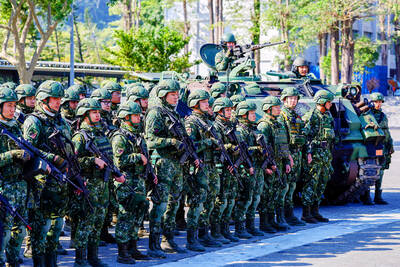Taiwan needs to develop its own anti-access and area-denial forces, a study presented to the US-China Economic and Security Review Commission by US Naval War College associate professor William Murray says.
The study says that with China’s massive military expansion, the Republic of China (ROC) Air Force and much of the ROC Navy are “likely no longer survivable” during wartime.
“Yet Taipei needs the capacity to ride out bombardment, withstand a blockade and to repel an invading amphibious fleet,” Murray says.
Among his major proposals is that Taiwan consider the example of Iran’s Peykaap-class missile patrol craft. The vessels are about 18m long, displace about 13.5 tonnes and can achieve speeds of 52 knots (96kph).
“These or similar vessels’ small size makes them easier and cheaper to build, so Taiwan could produce large numbers of them indigenously,” the study says.
“Small size would also permit the wartime use of ports of all sizes, making basing and logistics less vulnerable during combat,” it says.
Taiwan could easily disperse and hide these lethal craft — armed with anti-ship cruise missiles — making them much less susceptible to Chinese short-range ballistic missiles, it adds.
“Such vessels could be sent on their attack missions individually or in groups with only rudimentary location data, conduct extended searches with their own radar, develop final targeting data autonomously, deliver lethal ordinance from beyond effective counter-fire range and escape at high speed to reload,” Murray says.
The fast attack craft could extend lethal combat power for tens of kilometers from Taiwan and make those waters too dangerous for intruding Chinese warships, especially amphibious ships preparing to conduct an invasion, he says.
Taiwan should field large numbers of modern, mobile, short-range surface-to-air missiles and use its Patriot missiles for air defense, instead of missile defense, Murray says.
This would force hostile aircraft to fly above the effective missile altitude — about 6km — thus reducing attacking pilots’ ability to positively identify and accurately attack targets, especially those that are mobile.
The study concluded that submarines are “probably not really affordable” to Taiwan and would have limited use in the case of a Chinese attack.
Rather, Taiwan needs large numbers of small, lethal, highly mobile weapons systems, such as truck-mounted coastal-defense cruise missiles, short-range vehicle-mounted surface-to-air missiles, mobile multiple-rocket launchers, attack helicopters, sea mines and small, fast missile-patrol craft firing short-ranged cruise missiles — all of which could hide in hardened bunkers when not in use, he says.
“Such survivable forces are ideal for a vicious series of short-range engagements that would result in the destruction or greatly-reduced efficacy of China’s attack aircraft and surface combatants, including especially Beijing’s amphibious assault ships,” the study says.
Murray says the US Congress should encourage Taiwan to develop or buy small, mobile, lethal weapons systems and that the US discourage Taiwan from further development of offensive weapons systems, such as land-attack cruise missiles.
He also says the US Congress should encourage Taipei to spend no less than 3 percent of its GDP on defense.
Murray’s study was first presented at a conference organized by the School of Oriental and African Studies.

The Central Weather Administration (CWA) today issued a sea warning for Typhoon Fung-wong effective from 5:30pm, while local governments canceled school and work for tomorrow. A land warning is expected to be issued tomorrow morning before it is expected to make landfall on Wednesday, the agency said. Taoyuan, and well as Yilan, Hualien and Penghu counties canceled work and school for tomorrow, as well as mountainous district of Taipei and New Taipei City. For updated information on closures, please visit the Directorate-General of Personnel Administration Web site. As of 5pm today, Fung-wong was about 490km south-southwest of Oluanpi (鵝鑾鼻), Taiwan's southernmost point.

UNILATERAL MOVES: Officials have raised concerns that Beijing could try to exert economic control over Kinmen in a key development plan next year The Civil Aviation Administration (CAA) yesterday said that China has so far failed to provide any information about a new airport expected to open next year that is less than 10km from a Taiwanese airport, raising flight safety concerns. Xiamen Xiangan International Airport is only about 3km at its closest point from the islands in Kinmen County — the scene of on-off fighting during the Cold War — and construction work can be seen and heard clearly from the Taiwan side. In a written statement sent to Reuters, the CAA said that airports close to each other need detailed advanced

Tropical Storm Fung-Wong would likely strengthen into a typhoon later today as it continues moving westward across the Pacific before heading in Taiwan’s direction next week, the Central Weather Administration (CWA) said. As of 8am, Fung-Wong was about 2,190km east-southeast of Cape Oluanpi (鵝鑾鼻), Taiwan’s southernmost point, moving westward at 25kph and possibly accelerating to 31kph, CWA data showed. The tropical storm is currently over waters east of the Philippines and still far from Taiwan, CWA forecaster Tseng Chao-cheng (曾昭誠) said, adding that it could likely strengthen into a typhoon later in the day. It is forecast to reach the South China Sea

Almost a quarter of volunteer soldiers who signed up from 2021 to last year have sought early discharge, the Legislative Yuan’s Budget Center said in a report. The report said that 12,884 of 52,674 people who volunteered in the period had sought an early exit from the military, returning NT$895.96 million (US$28.86 million) to the government. In 2021, there was a 105.34 percent rise in the volunteer recruitment rate, but the number has steadily declined since then, missing recruitment targets, the Chinese-language United Daily News said, citing the report. In 2021, only 521 volunteers dropped out of the military, the report said, citing